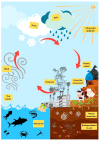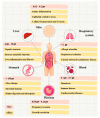Sources, Degradation, Ingestion and Effects of Microplastics on Humans: A Review
- PMID: 37755757
- PMCID: PMC10534390
- DOI: 10.3390/toxics11090747
Sources, Degradation, Ingestion and Effects of Microplastics on Humans: A Review
Abstract
Celluloid, the predecessor to plastic, was synthesized in 1869, and due to technological advancements, plastic products appear to be ubiquitous in daily life. The massive production, rampant usage, and inadequate disposal of plastic products have led to severe environmental pollution. Consequently, reducing the employment of plastic has emerged as a pressing concern for governments globally. This review explores microplastics, including their origins, absorption, and harmful effects on the environment and humans. Several methods exist for breaking down plastics, including thermal, mechanical, light, catalytic, and biological processes. Despite these methods, microplastics (MPs, between 1 and 5 mm in size) continue to be produced during degradation. Acknowledging the significant threat that MPs pose to the environment and human health is imperative. This form of pollution is pervasive in the air and food and infiltrates our bodies through ingestion, inhalation, or skin contact. It is essential to assess the potential hazards that MPs can introduce. There is evidence suggesting that MPs may have negative impacts on different areas of human health. These include the respiratory, gastrointestinal, immune, nervous, and reproductive systems, the liver and organs, the skin, and even the placenta and placental barrier. It is encouraging to see that most of the countries have taken steps to regulate plastic particles. These measures aim to reduce plastic usage, which is essential today. At the same time, this review summarizes the degradation mechanism of plastics, their impact on human health, and plastic reduction policies worldwide. It provides valuable information for future research on MPs and regulatory development.
Keywords: environmental pollution; food chain; hazards; health; microplastics; plastics reduction.
Conflict of interest statement
The authors declare that they have no known competing financial interest or personal relationship that could have influenced the work reported in this paper.
Figures





Similar articles
-
The Minderoo-Monaco Commission on Plastics and Human Health.Ann Glob Health. 2023 Mar 21;89(1):23. doi: 10.5334/aogh.4056. eCollection 2023. Ann Glob Health. 2023. PMID: 36969097 Free PMC article. Review.
-
An insight decipher on photocatalytic degradation of microplastics: Mechanism, limitations, and future outlook.Environ Res. 2024 Apr 15;247:118268. doi: 10.1016/j.envres.2024.118268. Epub 2024 Jan 19. Environ Res. 2024. PMID: 38244970 Review.
-
Plastic or plastic-free life: From formation to removal.Sci Total Environ. 2023 Sep 10;890:164359. doi: 10.1016/j.scitotenv.2023.164359. Epub 2023 May 22. Sci Total Environ. 2023. PMID: 37225102 Review.
-
Human health concerns regarding microplastics in the aquatic environment - From marine to food systems.Sci Total Environ. 2022 Jun 1;823:153730. doi: 10.1016/j.scitotenv.2022.153730. Epub 2022 Feb 7. Sci Total Environ. 2022. PMID: 35143789 Review.
-
Recent advances in biodegradation of emerging contaminants - microplastics (MPs): Feasibility, mechanism, and future prospects.Chemosphere. 2023 Aug;331:138776. doi: 10.1016/j.chemosphere.2023.138776. Epub 2023 Apr 24. Chemosphere. 2023. PMID: 37100247 Review.
Cited by
-
Microplastic Pollution: A Global Environmental Crisis Impacting Marine Life, Human Health, and Potential Innovative Sustainable Solutions.Int J Environ Res Public Health. 2025 Jun 2;22(6):889. doi: 10.3390/ijerph22060889. Int J Environ Res Public Health. 2025. PMID: 40566316 Free PMC article. Review.
-
Progress and Prospects of Microplastic Biodegradation Processes and Mechanisms: A Bibliometric Analysis.Toxics. 2024 Jun 26;12(7):463. doi: 10.3390/toxics12070463. Toxics. 2024. PMID: 39058115 Free PMC article. Review.
-
Novel decomposition of polycarbonate and effect for marine ecosystem.RSC Adv. 2023 Oct 12;13(42):29668-29674. doi: 10.1039/d3ra04127a. eCollection 2023 Oct 4. RSC Adv. 2023. PMID: 37842072 Free PMC article.
-
Heavy metal concentrations in soil and ecological risk assessment in the vicinity of Tianzhu Industrial Park, Qinghai-Tibet Plateau.PeerJ. 2024 Nov 15;12:e18510. doi: 10.7717/peerj.18510. eCollection 2024. PeerJ. 2024. PMID: 39559325 Free PMC article.
-
Effects of dietary acrylamide on kidney and liver health: Molecular mechanisms and pharmacological implications.Toxicol Rep. 2024 Dec 10;14:101859. doi: 10.1016/j.toxrep.2024.101859. eCollection 2025 Jun. Toxicol Rep. 2024. PMID: 39758802 Free PMC article. Review.
References
-
- Bhuyan M.S. Effects of microplastics on fish and in human health. Front. Environ. Sci. 2022;10:827289. doi: 10.3389/fenvs.2022.827289. - DOI
-
- Wieland S., Balmes A., Bender J., Kitzinger J., Meyer F., Ramsperger A.F.R.M., Roeder F., Tengelmann C., Wimmer B.H., Laforsch C., et al. From properties to toxicity: Comparing microplastics to other airborne microparticles. J. Hazard. Mater. 2022;428:128151. doi: 10.1016/j.jhazmat.2021.128151. - DOI - PubMed
-
- Godara S.S., Yadav A., Goswami B., Rana R.S. Review on history and characterization of polymer composite materials. Mater. Today Proc. 2021;44:2674–2677. doi: 10.1016/j.matpr.2020.12.680. - DOI
Publication types
LinkOut - more resources
Full Text Sources

